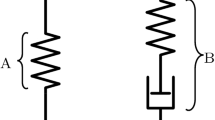Abstract
Stable crack propagation in filled rubber is investigated by means of experimental and finite element analyses. Based on an experimental evaluation of multiple specimens under different loading states, dissipation rates are computed by applying a global energy balance. The dissipation rates calculated analogously from results of a numerical simulation of the multiple specimen method are in good accordance with the experimental findings. A further comparison of simulation results evaluated on basis of the material force method with energy release rates computed by means of an energy balance of two crack states under fixed loading conditions shows that the measured fracture sensitivity values are mainly related to the development and increase of a dissipative zone.











Similar content being viewed by others
References
Arruda E, Boyce M (1993) A three-dimensional constitutive model for the large stretch behavior of rubber elastic materials. J Mech Phys Solids 41:389–412
Brocks W, Anuschewski P (2004) Parametrizing ductile tearing resistance by four parameters. Eng Fract Mech 71:127–146
Cohen A (1991) A Padé approximant to the inverse Langevin function. Rheologica Acta 30:270–273
Dal H, Kaliske M (2009) Bergström-Boyce model for nonlinear finite rubber viscoelasticity: theoretical aspects and algorithmic treatment for the FE method. Comput Mech 44:809–823
Gdoutos E (1993) Fracture mechanics—An introduction. Kluwer, Dordrecht, The Netherlands
Griffith A (1921) The phenomena of rupture and flow in solids. Philos Trans R Soc Lond Ser A, Math Phys Sci 221:163–198
Hui CY, Jagota A, Bennison S, Londono J (2003) Crack blunting and the strength of soft elastic solids. Proc R Soc Lond Ser A, Math Phys Eng Sci 459:1489–1516
Kaliske M, Rothert H (1998) Constitutive approach to rate-independent properties of filled elastomers. Int J Solids Struct 35:2057–2071
Kaliske M, Netzker C, Näser B (2009) Evaluation of crack driving forces at finite viscoelasticity: theory and experiments. In: Steinmann P (ed) IUTAM symposium: progress in the theory and numerics of configurational mechanics. Springer, Dordrecht, pp 193–202
Kanninen M, Popelar C (1985) Advanced fracture mechanics. Oxford University Press, Oxford
Klüppel M (2003) The role of disorder in filler reinforcement of elastomers on various length scales. Adv Polym Sci 164:1–86
Kolednik O, Turner C (2007) Application of energy dissipation rate arguments to ductile instability. Fatigue Fract Eng Mater Struct 17:1129–1145
Krishnan V, Hui C, Long R (2008) Finite strain crack tip fields in soft incompressible elastic solids. Langmuir 24:14245–14253
Marsden J, Hughes T (1994) Mathematical foundations of elasticity. Dover Publications, New York
Maugin G (1993) Material inhomogeneities in elasticity. Chapman & Hall, London
Maugin G (1995) Material forces: concepts and applications. Appl Mech Rev 48:213–245
Memhard D, Brocks W, Fricke S (2007) Characterization of ductile tearing resistance by energy dissipation rate. Fatigue Fract Eng Mater Struct 16:1109–1124
Miehe C, Keck J (2000) Superimposed finite elastic-viscoelastic-plastoelastic stress response with damage in filled rubbery polymers. Experiments, modelling and algorithmic implementation. J Mech Phys Solids 48:323–365
Mueller R, Kolling S, Gross D (2001) On configurational forces in the context of the finite element method. Int J Numer Methods Eng 53:1557–1574
Näser B, Kaliske M, Müller R (2007) Material forces for inelastic models at large strains: application to fracture mechanics. Comput Mech 40:1005–1013
Netzker C, Dal H, Kaliske M (2010) An endochronic plasticity formulation for filled rubber. Int J Solids Struct 47:2371–2379
Rivlin R, Thomas A (1953) Rupture of rubber. I. Characteristic energy for tearing. J Polym Sci 10:291–318
Simha N, Fischer F, Shan G, Chen C, Kolednik O (2008) J-integral and crack driving force in elastic-plastic materials. J Mech Phys Solids 56:2876–2895
Steinmann P (2000) Application of material forces to hyperelastostatic fracture mechanics. I. Continuum mechanical setting. Int J Solids Struct 37:7371–7391
Steinmann P, Ackermann D, Barth F (2001) Application of material forces to hyperelastostatic fracture mechanics. II. Computational setting. Int J Solids Struct 38:5509–5526
Strobl G (2007) The physics of polymers: concepts for understanding their structures and behavior. Springer, Berlin
Sumpter J (1999) An alternative view of R curve testing. Eng Fract Mech 64:161–176
Sumpter J (2004a) The energy dissipation rate approach to tearing instability. Eng Fract Mech 71:17–37
Sumpter J (2004b) Energy rates and crack stability in small scale yielding. Int J Fract 130:667–681
Valanis K (1971) A theory of viscoplasticity without a yield surface. Arch Mech 23:517–533
Acknowledgments
The support of this work within the research group FOR 597 “Fracture Mechanics and Statistical Mechanics of Reinforced Elastomeric Blends” by the Deutsche Forschungsgemeinschaft (DFG) under contracts KA1163/3-1, KA1163/3-2, HE446/3-1, HE4466/3-2, GR 1141/26-1 and GR 1141/26-2 is gratefully acknowledged.
Author information
Authors and Affiliations
Corresponding author
Rights and permissions
About this article
Cite this article
Netzker, C., Horst, T., Reincke, K. et al. Analysis of stable crack propagation in filled rubber based on a global energy balance. Int J Fract 181, 13–23 (2013). https://doi.org/10.1007/s10704-013-9816-5
Received:
Accepted:
Published:
Issue Date:
DOI: https://doi.org/10.1007/s10704-013-9816-5




